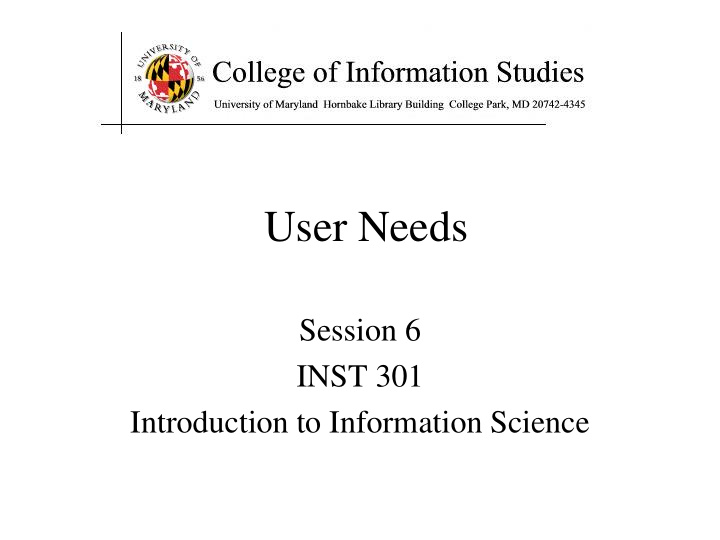



User Needs Session 6 INST 301 Introduction to Information Science
Muddiest Points • Link types (in, out, back, forward, …) • The TF*IDF formula • Behavior
The PageRank Paper
What are Humans Good At? • Sense low level stimuli • Recognize patterns • Reason inductively • Communicate with multiple channels • Apply multiple strategies • Adapt to changes or unexpected events
What are Computers Good At? • Sense stimuli outside human’s range • Calculate quickly and accurately • Store large quantities and recall accurately • Respond rapidly and consistently • Perform repetitive actions reliably • Work under heavy load for an extended period
Synergy • Humans do what they are good at • Computers do what they are good at • Strengths of one cover weakness of the other
Human Senses • Visual – Position/motion, color/contrast, symbols • Auditory – Position/motion, tones/volume, speech • Haptic – Mechanical, thermal, electrical, kinesthethic • Olfactory – Smell, taste • Vestibular
User Characteristics • Perceptual – The five senses • Physical – Anthropomorphic (height, left handed, etc.) – Age (mobility, dexterity, etc.) • Cognitive – Conceptual – Cultural
Transfer Effects • People transfer expectations from similar objects – Positive: prior learning applies to new situation – Negative: prior learning conflicts with new situation
Caller: Hello, is this Tech Support?" Tech: Yes, it is. How may I help you? Caller: The cup holder on my PC is broken and I am within my warranty period. How do I go about getting that fixed? Tech: I'm sorry, but did you say a cup holder? Caller: Yes, it's attached to the front of my computer. Please excuse me if I seem a bit stumped, it’s because I am. Did Tech: you receive this as part of a promotional, at a trade show? How did you get this cup holder? Does it have any trademark on it? Caller: It came with my computer, I don't know anything about a promotional. It just has '4X' on it. At this point the Tech Rep had to mute the call, because he couldn't stand it. The caller had been using the load drawer of the CD-ROM drive as a cup holder, and snapped it off the drive.
Types of User Needs • Informational (30-40% of queries) – What is a quark? • Navigational – Find the home page of United Airlines – Refinding something you have found before • Transactional – Data: What is the weather in Paris? – Shopping: Who sells a Viao Z505RX? – Proprietary: Obtain a journal article
Pass, et al., “A Picture of Search,” 2007
Pass, et al., “A Picture of Search,” 2007
Burstiness Query: Earthquake http://www.google.com/trends/
Query Statistics Pass, et al., “A Picture of Search,” 2007
User Needs Exercise • Form teams with diverse expertise • Think about a specific search problem – User needs, user characteristics • Identify needed system capabilities
Multilingual Access to Large Spoken Archives Douglas W. Oard University of Maryland, College Park, MD, USA William Byrne, Martin Franz, Lisa Goodgame, Samuel Gustman, Jan Hajic, Michael Picheny, Josef Psutka, Bhuvana Ramabhadran, Dagobert Soergel
Who Uses the Collection? Discipline Products • History • Book • Linguistics • Documentary film • Journalism • Research paper • Material culture • CDROM • Education • Study guide • Psychology • Obituary • Political science • Evidence • Law enforcement • Personal use Based on analysis of 280 access requests
Question Types • Content – Person, organization – Place, type of place (e.g., camp, ghetto) – Time, time period – Event, subject • Mode of expression – Language – Displayed artifacts (photographs, objects, …) – Affective reaction (e.g., vivid, moving, …) • Age appropriateness
Observational Studies Workshop 1 (June) Workshop 2 (August) • Four searchers • Four searchers – History/Political Science – Ethnography – Holocaust studies – German Studies – Holocaust studies – Sociology – Documentary filmmaker – High school teacher • Sequential observation • Simultaneous observation • Rich data collection • Opportunistic data collection – Intermediary interaction – Intermediary interaction – Semi-structured interviews – Semi-structured interviews – Observational notes – Observational notes – Think-aloud – Focus group discussions – Screen capture
Thesaurus-Based Search
Segment Viewer
Observed Selection Criteria • Topicality (57%) Judged based on: Person, place, … • Accessibility (23%) Judged based on: Time to load video • Comprehensibility (14%) Judged based on: Language, speaking style
Functionality Needed Function Boolean Search and Ranked Retrieval (13) Testimony summary (12) Pre-Interview Questionnaire search/viewer (9) Rapid access (7) Related/Alternative search terms (3) Adding multiple search terms at once (2) Keywords linked to segment number for easy access(1) Multi-tasking (1) Searching testimonies by places under ‘Experience Search’ (1) Extensive editing within ‘My Project’ (1) Desired Function Temporary saving of selected testimonies (4) Remote access (3) Integrated user tools for note taking (3) Map presentation (2) Reference tool (1) More repositories (1) Introductory video of system tutorial (1) Help (1)
Search Strategies
Recommend
More recommend